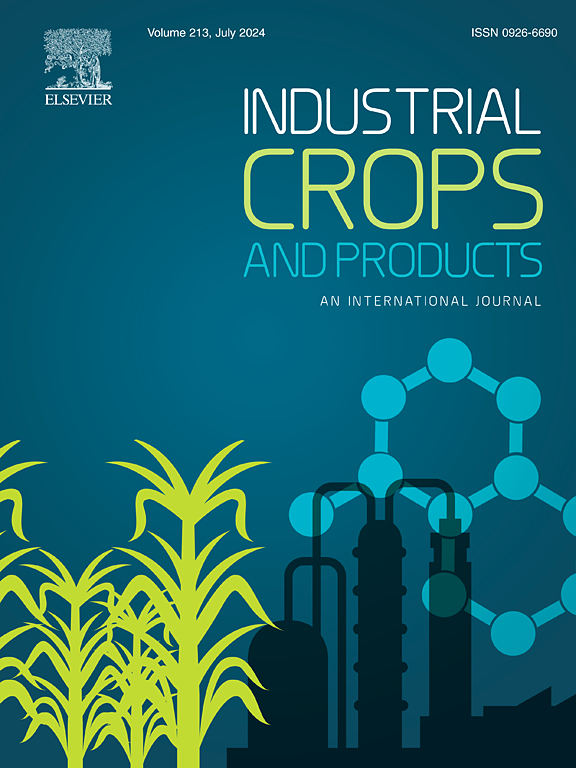甘蔗甘油醛-3-磷酸脱氢酶的分子鉴定及其与甘蔗SCMV感染的关系
IF 5.6
1区 农林科学
Q1 AGRICULTURAL ENGINEERING
引用次数: 0
摘要
甘油醛-3-磷酸脱氢酶(GAPDH)是糖酵解的关键酶之一,在植物生长发育和植物与病原体相互作用中起着重要作用。然而,对甘蔗(Saccharum spp. hybrid) GAPDH家族基因的特性和功能的研究仍然缺乏。本研究在甘蔗品种R570和XTT22中分别鉴定出24个、75个和91个GAPDH基因。系统发育树将这些基因划分为4个类群,即GAPC类群、GAPA类群、GAPB类群和GAPCp类群。这些GAPDH基因含有多个与应激和激素反应相关的顺式作用元件。RNA-seq分析表明,自发性葡萄球菌GAPDH基因和XTT22-GAPDH基因在不同发育阶段或不同组织中均有组成性表达。ScGAPA、ScGAPB、ScGAPC和ScGAPCp分别是从甘蔗栽培品种XTT22中分离得到的GAPDH家族的代表分子。RTqPCR分析显示,ScGAPA和ScGAPB在叶片中的表达量指数高于ScGAPC和ScGAPCp;这4个基因在SCMV感染和NaCl、水杨酸、H2O2或MeJA等非生物处理后均有差异表达。DAB染色和ATG8-I和ATG8-II检测表明,SCMV感染诱导甘蔗叶片活性氧爆发和自噬。ScGAPA、ScGAPB、ScGAPC和ScGAPCp与scgg3相互作用,从而抑制本烟植物的自噬。然而,氧化应激损害了scgg3与ScGAPA、ScGAPB、ScGAPC和ScGAPCp的相互作用,表明SCMV感染通过破坏scgaph - ScATG3的相互作用来激活自噬。本研究揭示了甘蔗GAPDH基因家族的起源和进化,以及该基因家族在应对甘蔗花叶病毒(SCMV)感染中的潜在作用。本文章由计算机程序翻译,如有差异,请以英文原文为准。

Molecular identification of sugarcane glyceraldehyde-3-phosphate dehydrogenases and their involvement in SCMV infection in sugarcane
Glyceraldehyde-3-phosphate dehydrogenase (GAPDH) is one of the key enzymes of glycolysis and plays important roles in plant growth, development and plant–pathogen interactions. However, studies on the characteristics and functions of sugarcane (Saccharum spp. hybrid) GAPDH family genes are still lacking. In the present study, 24, 75 and 91 GAPDH genes were identified in Saccharum spontaneum and sugarcane cultivars R570 and XTT22, respectively. A phylogenetic tree revealed that these genes could be divided into four groups, i.e., the GAPC group, the GAPA group, the GAPB group and the GAPCp group. These GAPDH genes contained multiple cis-acting elements related to stress and hormone response. RNA-seq analysis demonstrated that the S. spontaneum GAPDH genes and XTT22-GAPDH genes were constitutively expressed at different developmental stages or in different tissues. ScGAPA, ScGAPB, ScGAPC and ScGAPCp, representatives of each group of the GAPDH family, were isolated from the sugarcane cultivar XTT22. RT![]() qPCR analysis revealed that the expression levels of ScGAPA and ScGAPB were exponentially greater than those of ScGAPC or ScGAPCp in the leaves; these four genes were differentially expressed upon SCMV infection and after abiotic treatments such as NaCl, salicylic acid, H2O2 or MeJA. DAB staining and detection of ATG8-I and ATG8-II demonstrated that SCMV infection induces bursts of reactive oxygen species and autophagy in sugarcane leaves. ScGAPA, ScGAPB, ScGAPC, and ScGAPCp interacted with ScATG3, thereby suppressing autophagy in Nicotiana benthamiana plants. However, oxidative stress impaired the interaction of ScATG3 with ScGAPA, ScGAPB, ScGAPC and ScGAPCp, indicating that SCMV infection activates autophagy by disrupting ScGAPDH–ScATG3 interactions. The present study reveals the origin and evolution of the GAPDH gene family in sugarcane and the potential roles of this gene family in response to sugarcane mosaic virus (SCMV) infection.
qPCR analysis revealed that the expression levels of ScGAPA and ScGAPB were exponentially greater than those of ScGAPC or ScGAPCp in the leaves; these four genes were differentially expressed upon SCMV infection and after abiotic treatments such as NaCl, salicylic acid, H2O2 or MeJA. DAB staining and detection of ATG8-I and ATG8-II demonstrated that SCMV infection induces bursts of reactive oxygen species and autophagy in sugarcane leaves. ScGAPA, ScGAPB, ScGAPC, and ScGAPCp interacted with ScATG3, thereby suppressing autophagy in Nicotiana benthamiana plants. However, oxidative stress impaired the interaction of ScATG3 with ScGAPA, ScGAPB, ScGAPC and ScGAPCp, indicating that SCMV infection activates autophagy by disrupting ScGAPDH–ScATG3 interactions. The present study reveals the origin and evolution of the GAPDH gene family in sugarcane and the potential roles of this gene family in response to sugarcane mosaic virus (SCMV) infection.
求助全文
通过发布文献求助,成功后即可免费获取论文全文。
去求助
来源期刊

Industrial Crops and Products
农林科学-农业工程
CiteScore
9.50
自引率
8.50%
发文量
1518
审稿时长
43 days
期刊介绍:
Industrial Crops and Products is an International Journal publishing academic and industrial research on industrial (defined as non-food/non-feed) crops and products. Papers concern both crop-oriented and bio-based materials from crops-oriented research, and should be of interest to an international audience, hypothesis driven, and where comparisons are made statistics performed.
 求助内容:
求助内容: 应助结果提醒方式:
应助结果提醒方式:


